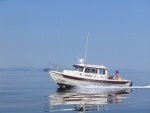Pandion":2mvzofsu said:
Rob, as a lay person it is hard for me to comprehend why a commander, asleep in his bunk, would be found culpable in an incident of this kind.
Thanks to RobLL and Spuncopper for their prospective! I served in the Army, but there if there was any potential issue, the CO and OOD were notified immediately.
On my own, and other recreational vessels I have crewed on, the standing order was for who was on watch to call the skipper immediately, if any question or any potential danger.! At night we kept Radar on, we did visual scans of 360 degrees at least every 5 minutes--no matter what the weather.
The major question remains why the Fitzgerald did not seem to recognize the presence of the merchant ship?
I read the report, and basically the time line leaves out any information prior to the collision. I suspect that future reports may/or may not, establish the actions, if any of the Fitzgerald, prior to the collision. I think that confounds all of us, that there was no recognition on radar or visual watch.
Radio--I have experienced being in the midst of naval operations at night where no naval ship responded to my VHF "Security" calls. I called USCG on the HF SSB radio, since I was out of VHF range of shore. Very shortly after my call to the Coast Guard, the Captain of the 968' Air Craft carrier CV43 "Coral Sea", was on the VHF radio assuring me, that they were tracking our 38 foot sail boat, and there was no danger, even though the ships were running dark, except for minimal navigation lights.
RobLL's comment about using Cell Phone to contact division commander is interesting. It does appear the radio room was flooded and out of commission. Hard to believe that the bridge did not have both VHF and HF radio on the bridge or some secondary station. Even our recreational boats had two separate VHF radios, and separate antenna systems--plus 2 HF/SSB radios--again redundant. antenna systems (in case the mast was lost).
AIS No data for Fitzgerald. The Crystal had AIS on, and apparently was on a steady course, at a speed of 17 knots. Fitzgerald was reported to be at a speed of 20 knots, so Crystal would not have been "overtaking". Fitzgerald did not have AIS transmitting. Was no-one watching the receiver?--surely the Navy has plotters for AIS targets.
Adm. Bill Moran, said the report made clear that “serious mistakes were made by members of the crew.” As the shipping lanes got more crowded that night, Admiral Moran said the sailors on watch “lost situational awareness,” and by the time they realized their errors, it was too late to avoid a collision with the much larger freighter.
Fitzgerald. Commander Benson, as well as several sailors on watch that night, will face what the military calls nonjudicial punishment.
Non Judicial Punishment:
Article 15 of the Uniform Code of Military Justice. Non-judicial punishment or "NJP" permits commanders to administratively discipline troops without a court-martial.
It is not clear that this precludes a court marshal. (In the Army it was possible to still have a Court Martial. The captain is held responsible for the crew not recognizing the dangers and not awakening him.
One other issue I found interesting that there was no "dive team" or equipment on board the Fitzgerald. It is not clear that a rescue dive team could have gotten trapped sailors out of the berthing compartment. On our recreational cruising boats we carried both SCUBA tanks and Hookah dive system. Hookah only uses a single air hose, and safety line and avoids the bulk of the tanks, and BC. A number of times we have had to dive on the bottom of the boat to clear a prop, remove debris from an water intake, or inspect for damage while at sea. I was told in the 1990's that the Canadian Coast Guard dive teams were not allowed to go into a capsized vessel's flooded compartments to free trapped occupants--because of the risk to the diver. I don't know if this is still the policy, or would be Navy policy.
Such a tragedy.

